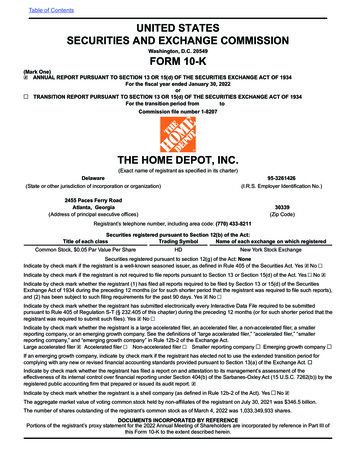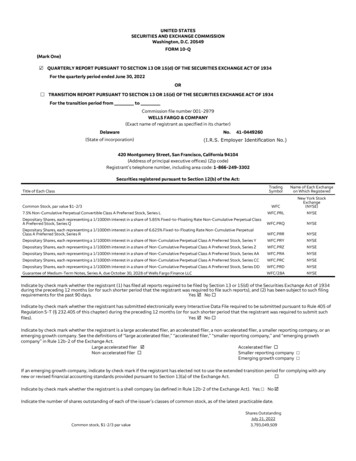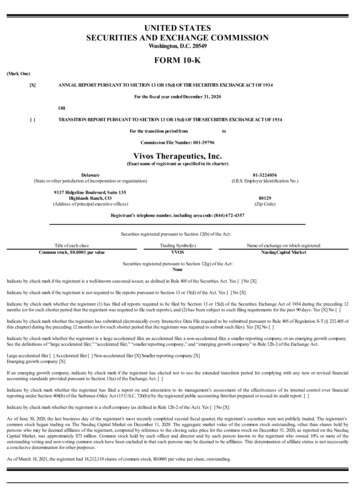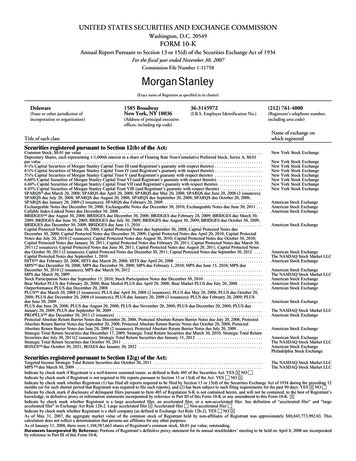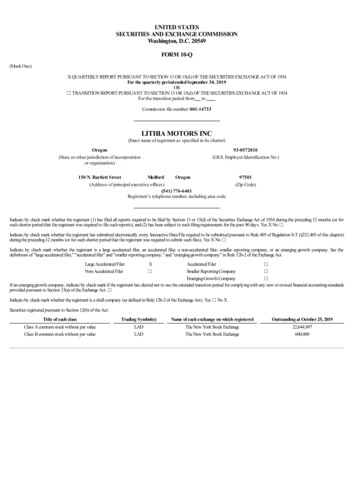
Transcription
Table of ContentsUNITED STATESSECURITIES AND EXCHANGE COMMISSIONWashington, D.C. 20549FORM 10-K(Mark One) ANNUAL REPORT PURSUANT TO SECTION 13 OR 15(d) OF THE SECURITIESEXCHANGE ACT OF 1934For the fiscal year ended October 31, 2021OR TRANSITION REPORT PURSUANT TO SECTION 13 OR 15(d) OF THE SECURITIESEXCHANGE ACT OF 1934For the transition period fromtoCommission File Number 0-19807SYNOPSYS, INC.(Exact name of registrant as specified in its charter)Delaware(State or other jurisdiction ofincorporation or organization)690 East Middlefield Road, Mountain View, California(Address of principal executive offices)56-1546236(I.R.S. EmployerIdentification No.)94043(Zip Code)(650) 584-5000(Registrant’s telephone number, including area code)Securities Registered Pursuant to Section 12(b) of the Act:Title of Each ClassCommon Stock(par value of 0.01 per share)Trading Symbol(s)SNPSName of Each Exchange on Which RegisteredNasdaq Global Select MarketSecurities Registered Pursuant to Section 12(g) of the Act: NoneIndicate by check mark if the registrant is a well-known seasoned issuer, as defined in Rule 405 of the Securities Act. Yes No Indicate by check mark if the registrant is not required to file reports pursuant to Section 13 or Section 15(d) of the Act. Yes No Indicate by check mark whether the registrant (1) has filed all reports required to be filed by Section 13 or 15(d) of the Securities Exchange Act of1934 during the preceding 12 months (or for such shorter period that the registrant was required to file such reports), and (2) has been subject tosuch filing requirements for the past 90 days. Yes No Indicate by check mark whether the registrant has submitted electronically every Interactive Data File required to be submitted pursuant to Rule405 of Regulation S-T (§ 232.405 of this chapter) during the preceding 12 months (or for such shorter period that the registrant was required tosubmit such files). Yes No Indicate by check mark whether the registrant is a large accelerated filer, an accelerated filer, a non-accelerated filer, a smaller reportingcompany, or an emerging growth company. See the definitions of “large accelerated filer,” “accelerated filer,” “smaller reporting company,” and"emerging growth company" in Rule 12b-2 of the Exchange Act.
Table of ContentsLarge accelerated filerýAccelerated Filer Non-accelerated filer Smaller reporting company Emerging growth company If an emerging growth company, indicate by check mark if the registrant has elected not to use the extended transition period for complying withany new or revised financial accounting standards provided pursuant to Section 13(a) of the Exchange Act. Indicate by check mark whether the registrant has filed a report on and attestation to its management’s assessment of the effectiveness of itsinternal control over financial reporting under Section 404(b) of the Sarbanes-Oxley Act (15 U.S.C. 7262(b)) by the registered public accountingfirm that prepared or issued its audit report. Indicate by check mark whether the registrant is a shell company (as defined in Rule 12b-2 of the Act).Yes No The aggregate market value of the voting and non-voting common equity held by non-affiliates computed by reference to the price at which thecommon equity was last sold as of the last business day of the registrant’s most recently completed second fiscal quarter was approximately 27.5 billion. Aggregate market value excludes an aggregate of approximately 41.3 million shares of common stock held by the registrant’sexecutive officers and directors and by each person known by the registrant to own 5% or more of the outstanding common stock on such date.Exclusion of shares held by any of these persons should not be construed to indicate that such person possesses the power, direct or indirect, todirect or cause the direction of the management or policies of the registrant, or that such person is controlled by or under common control withthe registrant.On December 8, 2021, 153,438,336 shares of the registrant’s Common Stock, par value of 0.01 per share, were outstanding.DOCUMENTS INCORPORATED BY REFERENCEPortions of the registrant’s Proxy Statement relating to the registrant’s 2022 Annual Meeting of Stockholders, scheduled to be held on April 12,2022, are incorporated by reference into Part III of this Annual Report on Form 10-K where indicated. Except as expressly incorporated byreference, the registrant’s Proxy Statement shall not be deemed to be part of this report.
Table of ContentsSYNOPSYS, INC.ANNUAL REPORT ON FORM 10-KFiscal year ended October 31, 2021TABLE OF CONTENTSPage No.PART IItem 1.Item 1A.Item 1B.Item 2.Item 3.Item 4.BusinessRisk FactorsUnresolved Staff CommentsPropertiesLegal ProceedingsMine Safety Disclosures31529292930Market for Registrant’s Common Equity, Related Stockholder Matters andIssuer Purchases of Equity Securities[Reserved]Management’s Discussion and Analysis of Financial Condition and Resultsof Operations31Quantitative and Qualitative Disclosures About Market RiskFinancial Statements and Supplementary DataChanges in and Disagreements with Accountants on Accounting andFinancial DisclosureControls and ProceduresOther InformationDisclosure Regarding Foreign Jurisdictions that Prevent Inspections444791929292Item 14.Directors, Executive Officers and Corporate GovernanceExecutive CompensationSecurity Ownership of Certain Beneficial Owners and Management andRelated Stockholder MattersCertain Relationships and Related Transactions, and DirectorIndependencePrincipal Accountant Fees and ServicesPART IVItem 15.Exhibits and Financial Statement Schedules93PART IIItem 5.Item 6.Item 7.Item 7A.Item 8.Item 9.Item 9A.Item 9B.Item 9C.PART IIIItem 10.Item 11.Item 12.Item 13.SIGNATURES3232919191929297i
Table of ContentsCautionary Note Regarding Forward-Looking StatementsThis Annual Report on Form 10-K (this Form 10-K or Annual Report) contains forward-looking statements within themeaning of Section 27A of the Securities Act of 1933, as amended (the Securities Act), Section 21E of theSecurities Exchange Act of 1934, as amended (the Exchange Act), and the Private Securities Litigation Reform Actof 1995. Any statements herein that are not statements of historical fact are forward-looking statements. Wordssuch as “may,” “will,” “could,” “would,” “can,” “should,” “anticipate,” “expect,” “intend,” “believe,” “estimate,” “project,”“continue,” “forecast,” “likely,” “potential,” “seek,” or the negatives of such terms and similar expressions areintended to identify forward-looking statements. This Form 10-K includes, among others, forward-looking statementsregarding: our business, product and platform strategies; our business outlook; the continued impact and duration of the COVID-19 pandemic; the impact of macroeconomic conditions, supply shortages, and trade disruptions on our businessand our customers’ businesses; demand for our products and our customers’ products; the expected realization of our contracted but unsatisfied or partially unsatisfied performanceobligations; our ability to successfully compete in the markets in which we serve; our license mix, our business model, and variability in our revenue; the continuation of current industry trends towards customer and vendor consolidation, and theimpact of such consolidation; prior and future acquisitions, including the expected benefits and risks of completed acquisitions; customer license renewals; the completion of development of our unfinished products, or further development or integration ofour existing products; technological trends in integrated circuit design; litigation; our ability to protect our intellectual property; our ability to attract and retain senior management and key employees; the impact of tax laws and changes in such laws on our business; the impact of new and recently adopted accounting pronouncements; regulatory changes in the United States and other regions in which we operate; our cash, cash equivalents and cash generated from operations; and our future liquidity requirements.These statements are based on our current expectations about future events and involve certain known andunknown risks, uncertainties and other factors that could cause our actual results, time frames or achievements todiffer materially from those expressed or implied in our forward-looking statements. Accordingly, we caution readersnot to place undue reliance on these statements. Such risks and uncertainties include, among others, those listed inPart I, Item 1A, Risk Factors of this Form 10-K. The information included herein represents our estimates andassumptions as of the date of this filing. Unless required by law, we undertake no obligation to update publicly anyforward-looking statements, or to update the reasons actual results could differ materially from those anticipated inthese forward-looking statements, even if new information becomes available in the future. All subsequent written ororal forward-looking statements attributable to Synopsys, Inc. or persons acting on our behalf are expressly1
Table of Contentsqualified in their entirety by these cautionary statements. Readers are urged to carefully review and consider thevarious disclosures made in this report and in other documents we file from time to time with the Securities andExchange Commission (SEC) that attempt to advise interested parties of the risks and factors that may affect ourbusiness.Fiscal Year EndOur fiscal year ends on the Saturday nearest to October 31 and consists of 52 weeks, with the exception thatapproximately every five years, we have a 53-week year. When a 53-week year occurs, we include the additionalweek in the first quarter to realign fiscal quarters with calendar quarters. Fiscal 2021, 2020 and 2019 were 52-weekyears and ended on October 30, 2021, October 31, 2020, November 2, 2019, respectively. Fiscal 2022 will be a 52week year.For presentation purposes, this Form 10-K refers to the closest calendar month end.2
Table of ContentsPART IItem 1.BusinessCompany and Segment OverviewSynopsys, Inc. provides products and services used across the entire Silicon to Software spectrum to bring SmartEverything to life. From engineers creating advanced semiconductors to product teams developing advancedelectronic systems to software developers seeking to ensure the security and quality of their code, our customerstrust that our technologies will enable them to meet new requirements for low power as well as reliability, mobility,and security.We are a global leader in supplying the electronic design automation (EDA) software that engineers use to designand test integrated circuits (ICs), also known as chips. We also offer semiconductor intellectual property (IP)products, which are pre-designed circuits that engineers use as components of larger chip designs rather thandesigning those circuits themselves. We provide software and hardware used to validate the electronic systems thatincorporate chips and the software that runs on them. To complement these offerings, we provide technical servicesand support to help our customers develop advanced chips and electronic systems. These products and servicesare part of our Semiconductor & System Design segment.We are also a leading provider of software tools and services that improve the security, quality and compliance ofsoftware in a wide variety of industries, including electronics, financial services, automotive, medicine, energy andindustrials. These tools and services are part of our Software Integrity segment.Corporate InformationWe incorporated in 1986 in North Carolina and reincorporated in 1987 in Delaware. Our headquarters are located at690 East Middlefield Road, Mountain View, California 94043, and our headquarters’ telephone number is(650) 584-5000. We have approximately 125 offices worldwide.Our annual and quarterly reports on Forms 10-K and 10-Q (including related filings in XBRL format), current reportson Form 8-K, and Proxy Statements relating to our annual meetings of stockholders (including any amendments tothese reports, as well as filings made by our executive officers and directors) are available through the InvestorRelations page of our website (www.synopsys.com) free of charge as soon as practicable after we file them with, orfurnish them to, the SEC (www.sec.gov). We use our Investor Relations page as a routine channel for distribution ofimportant information, including news releases, investor presentations, and financial information. The contents ofour website are not part of this Form 10-K.BackgroundIn this era of Smart Everything, we have seen a remarkable proliferation of consumer and wireless electronicproducts, particularly mobile devices. The growth of the Internet and cloud computing has provided people with newways to create, store, and share information. At the same time, the increasing use of electronics in cars, buildings,appliances, and other consumer products is creating a connected landscape of smart devices. Numerous softwareapplications (apps) have been developed to expand the potential of these connected devices. The increasingimpact of artificial intelligence and machine learning is driving an increase in the activity of new and existing chipand system design companies around the world.These developments have been fueled by innovation in the semiconductor and software industries. It is nowcommon for a single chip to combine many components (processor, communications, memory, custom logic, input/output) and embedded software into a single system-on-chip (SoC), necessitating highly complex chip designs. Themost complex chips today contain more than a billion transistors. Transistors are the basic building blocks for ICs,each of which may have features that are less than 1/1,000th the diameter of a human hair.These devices are manufactured using masks to direct beams of light onto a wafer of silicon. At such smalldimensions, the wavelength of light itself can become an obstacle to production, proving too big to create suchdense features and requiring creative and complicated new approaches. Designers have turned to newmanufacturing techniques to solve these problems, such as multiple-patterning lithography and FinFET, or 3Dtransistors, which in turn have introduced new challenges to design and production.3
Table of ContentsThe popularity of mobile devices and other electronic products has increased demand for chips and systems withgreater functionality and performance, reduced size, and lower power consumption. Our customers, who designthose products, are facing intense pressure to deliver innovative offerings in shorter timeframes and at lower prices.In other words, innovation in chip and system design often hinges on providing products “better,” “sooner,” and“cheaper” than competitors. The design of these chips and systems is extremely complex and necessitates state-ofthe-art solutions. Over the past several years, market verticals including AI, 5G, automotive and cloud computinginfrastructure have contributed to the ongoing demand for our products and services.A similar dynamic is at work in the software arena, whether the software is embedded on a chip or used in otherapplications. The pace of innovation often requires developers to deliver more secure, high-quality software, whichcan include millions of lines of code, in increasingly frequent release cycles. Bugs, defects, and securityvulnerabilities in code can be difficult to detect and expensive to fix. But, at a time when software is critical in manyindustries across a growing array of smart devices, it is crucial to have high-quality, secure code to ensureconsumers’ privacy and safety.Our Role—As the Silicon to Software PartnerSynopsys' Silicon to Software technologies and services are designed to help our customers—chip and systemengineers and software developers—to speed time to market, achieve the highest quality of results, mitigate risk,and maximize profitability.Chip and system designers must determine how best to design, locate, and connect the building blocks of chips,and to verify that the resulting design behaves as intended and can be manufactured efficiently and cost-effectively.This is a complex, multi-step process that is both expensive and time-consuming. Our wide range of products helpat different steps in the overall design process, from the design of individual ICs to the design of larger systems. Ourproducts increase designer productivity and efficiency by automating tasks, keeping track of large amounts of data,adding intelligence to the design process, facilitating reuse of past designs, and reducing errors. Our IP productsoffer proven, high-quality pre-configured circuits that are ready to use in a chip design, saving customers time andenabling them to direct resources to features that differentiate their products. Our global service and supportengineers also provide expert technical support and design assistance to our customers.Software developers are responsible for writing code that not only accomplishes its goals as efficiently as possible,but also runs securely and is free of defects. We offer products that can help developers write higher quality, moresecure code by analyzing code for quality defects and known security vulnerabilities, adding intelligence andautomation to the software testing process, and helping to eliminate defects in a systematic manner. As developersmake use of open source software in their code, our products can help developers better manage the compositionand security of the code. Our products enable software developers to catch flaws earlier in the development cycle,when they are less costly to fix.Products and ServicesSemiconductor & System Design SegmentOur Semiconductor & System Design segment includes the EDA, IP and System Integration and Other revenuecategories.EDADesigning ICs involves many complex steps: architecture definition, register transfer level (RTL) design, functional/RTL verification, logic design or synthesis, gate-level verification, floorplanning, place and route, and physicalverification, to name just a few. Designers use our EDA products to automate the IC design process, reduce errors,and enable more powerful and robust designs.As the availability and amount of cloud-based data storage grows, also growing in EDA is customer interest inaccessing EDA on the cloud, and the scalability and flexibility that cloud computing can offer to customer flows andengineering teams. This customer shift in interest has started and continues to grow. While many of our solutionshave been used in cloud-based environments for years, such as in a customer’s own server and/or cloudenvironment, we have been working directly with customers and commercial cloud vendors, including Amazon Web4
Table of ContentsServices, Microsoft Azure, Google Cloud and Alibaba Cloud, to further enhance our EDA-on-cloud products andplatforms.Our platforms comprehensively address the process, featuring a large number of EDA products that generally fallinto the following categories: Digital and custom IC design and field programmable gate array (FPGA) design, which includessoftware tools to design an IC; Verification, which includes technology to verify that an IC design behaves as intended; and Manufacturing, which includes products that both enable early manufacturing process developmentand convert IC design layouts into the masks used to manufacture the chips.Digital and Custom IC DesignOur Fusion Design Platform provides customers with a comprehensive digital design implementation solution thatincludes industry-leading products and redefines conventional design tool boundaries to deliver a more integratedflow than ever before, with better quality and time to results. The platform gives designers the flexibility to integrateinternally developed tools as well as those from third parties. With innovative technologies, a common foundation,and flexibility, our Fusion Design Platform helps reduce design times, decrease uncertainties in design steps, andminimize the risks inherent in advanced, complex IC design. The platform supports multiple technology nodes,including advanced nodes at 12nm, 10nm, 8/7nm, 6 nm, 5/4nm, and 3nm, with technology collaborations on nextgeneration process technologies.Key design products, available as part of the Fusion Design Platform, include Fusion Compiler RTL to GDSIIdesign implementation, Design Compiler logic synthesis, IC Compiler II physical design, Synopsys TestMAXTMtest and diagnosis, PrimeTime static timing analysis, StarRC parasitic extraction, IC Validator physicalverification and 3DIC Compiler, the industry’s first next-generation chip packaging solution, aimed at enablingcustomers to combine or stack multiple dice on a single chip. Many of our EDA solutions are bolstered by AI andmachine learning capabilities. In addition, we offer DSO.ai , which brings AI to the entire design process. Itautonomously learns through quickly exploring potential design alternatives, enabling engineers to develop superiordesign outcomes with our design tools.Our Custom Design Platform is a unified suite of design and verification tools that accelerates the transistor-leveldesign of robust analog, mixed-signal, and custom-digital ICs. The platform features visually assisted layoutautomation, high-performance circuit simulation, reliability-aware verification, and natively integrated StarRC extraction and physical verification. Platform tools include Custom Compiler layout and schematic editor, StarRCparasitic extraction, and IC Validator physical verification. The platform also includes PrimeSim Continuum.Launched in 2021, the PrimeSim Continuum solution integrates PrimeSim SPICE, PrimeSim HSPICE, PrimeSimPro and PrimeSim XA. The PrimeWave design environment is also included and provides comprehensiveanalysis and improved productivity and ease of use across all tools in PrimeSim Continuum.Our Silicon Lifecycle Management Platform is a new data analytics-driven platform that uses in-chip monitoring andsensing to optimize all phases of the silicon lifecycle—from design and manufacturing to in-field deployment andmaintenance. The platform is integrated with the Fusion Design Platform for design calibration and analytics andincludes Yield Explorer for product ramp analytics, SiliconDash for test and production analytics, TestMAX ALE(adaptive learning engine) for intelligent data extraction and communication to the SLM database and DesignWarePVT IP for in-chip monitoring and sensing.FPGA DesignFPGAs are complex chips that can be customized or programmed to perform a specific function after they aremanufactured. For FPGA design, we offer Synplify (Pro and Premier) implementation and Identify debugsoftware tools.VerificationOur Verification Continuum platform is built from our industry-leading and fastest verification technologies,providing virtual prototyping, static and formal verification, simulation, emulation, FPGA-based prototyping, anddebug in a unified environment with verification IP, planning, and coverage technology. By providing consistent5
Table of Contentscompile, runtime and debug environments across the flow of verification tasks and by enabling seamless transitionsacross functions, the platform helps our customers accelerate chip verification, bring up software earlier, and get tomarket sooner with advanced SoCs.The individual products included in the Verification Continuum platform are reported in our EDA and IP and SystemIntegration revenue categories. The solutions reported in our EDA revenue include the following: VC SpyGlass family of static verification technologies including lint, CDC (clock domain crossing),RDC (reset domain crossing), Constraint Checking, Synopsys TestMAX Advisor, and low-poweranalysis and verification; VCS functional verification solution, our comprehensive RTL and gate-level simulation technology,including Fine-Grained Parallelism; Verdi automated debug system, the industry’s most comprehensive SoC debug; VC Formal , our next-generation formal verification product; ZeBu emulation systems, which use high-performance hardware to emulate SoC designs so thatdesigners can accelerate hardware, software and power verification of large complex SoCs andperform earlier verification and optimization of the SoC together with software; and Other principal individual verification solutions, including the PrimeSim Continuum solution and thePrimeWave design environment.The verification IP, virtual prototyping, and FPGA-based prototyping solutions that are part of our VerificationContinuum platform are included in our IP and System Integration category and further described below.ManufacturingOur Manufacturing Solutions include Sentaurus technology computer-aided design device and process simulationproducts, Proteus mask synthesis tools, CATS mask data preparation software, Yield Explorer Odyssey, YieldManager yield management solutions and QuantumATK atomic-scale modeling software.We also provide consulting and design services that address all phases of the SoC development process, as wellas a broad range of expert training and workshops on our latest tools and methodologies.IP and System IntegrationIP ProductsAs more functionality converges into a single device or even a single chip, and as chip designs grow more complex,the number of third-party IP blocks incorporated into designs is rapidly increasing. We provide the broadest, mostcomprehensive portfolio of high-quality, silicon-proven IP solutions for SoCs. Our broad DesignWare IP portfolioincludes: High-quality solutions for widely used wired and wireless interfaces such as USB, PCI Express,DDR, Ethernet, SATA, MIPI, HDMI, and Bluetooth Low Energy; Logic libraries and embedded memories, including memory compilers, non-volatile memory,standard cells, and integrated test and repair; Processor solutions, including configurable ARC processor cores, software, Embedded Visionprocessor cores and application-specific instruction-set processor tools for embedded applications; IP subsystems for audio, sensor, and data fusion functionality that combine IP blocks, an efficientprocessor, and software into an integrated, pre-verified subsystem; Security IP solutions, including cryptographic cores and software, security subsystems, platformsecurity and content protection IP; An industry-leading offering of IP for the automotive market, optimized for strict functional safetyand reliability standards such as ISO 26262;6
Table of Contents Analog IP including data converters and audio codecs; and SoC infrastructure IP, datapath and building block IP, mathematical and floating-point components,Arm AMBA interconnect fabric and peripherals, and verification IP.Our IP Accelerated initiative augments our established, broad portfolio of silicon-proven DesignWare IP with IPPrototyping Kits and customized IP subsystems to accelerate prototyping, software development, and integration ofIP into SoCs.We offer a broad portfolio of IP that has been optimized to address specific application requirements for the mobile,automotive, digital home, internet of things, and cloud computing markets, enabling designers to quickly developSoCs in these areas.Our Verification IP portfolio, part of our Verification Continuum platform, is also part of the IP Products category.System Integration SolutionsOur System Integration verification solutions include the following elements of our Verification Continuum platform: HAPS FPGA-based prototyping systems, which are integrated and scalable hardware-softwaresolutions for early software development and faster time to market; Virtualizer virtual prototyping solution, which addresses the increasing development challengesassociated with software-rich semiconductor and electronic products by accelerating both thedevelopment and deployment of virtual prototypes; and Platform Architect solution, which provides for early analysis and optimization of multi-core SoCarchitectures for performance and power.We also provide a series of tools used in the design of optical systems and photonic devices. Our CODE V solutionenables engineers to model, analyze and optimize designs for optical imaging and communication systems. OurLightTools design and analysis software allows designers to simulate and improve the performance of a broadrange of illumination systems, from vehicle lighting to projector systems.OtherOur Other revenue category includes revenue from sales of products to academic and research institutions.Software Integrity SegmentOur Software Integrity segment helps organizations align people, processes, and technology to intelligently addresssoftware risks across their portfolio and at all stages of the application lifecycle. The testing tools, services, andprograms enable our customers to manage open source license compliance and detect, prioritize, and remediatesecurity vulnerabilities and defects across their entire software development lifecycle. Our offerings include securityand quality testing products, managed services, programs and professional services, and training offered as onpremises and cloud-based delivery.The Polaris Software Integrity PlatformTM is designed to bring our products and services together into an integrated,easy-to-use solution that enables security and development teams to build secure, high-quality software faster.7
Table of ContentsKey offerings in this space include: Intelligent Orchestration solution, which enables DevOps to build a testing pipeline that enables acompany to define – within its particular policy guidelines – the rules to determine which tests torun, including the Synopsys portfolio tests, third party products, or open source tests; Code Dx, which correlates and prioritizes findings from the Synopsys portfolio, third party products,and open source
Item 7. Management's Discussion and Analysis of Financial Condition and Results of Operations 32 Item 7A. Quantitative and Qualitative Disclosures About Market Risk 44 Item 8. Financial Statements and Supplementary Data 47 Item 9. Changes in and Disagreements with Accountants on Accounting and Financial Disclosure 91 Item 9A. Controls and .
